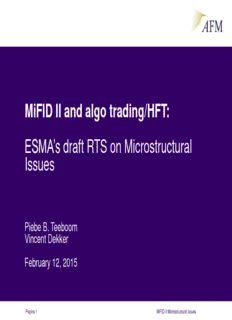
MiFID II and algo trading/HFT PDF
Preview MiFID II and algo trading/HFT
MiFID II and algo trading/HFT: ESMA’s draft RTS on Microstructural Issues Piebe B. Teeboom Vincent Dekker February 12, 2015 Pagina 1 MiFID-II Microstructural Issues Agenda • AFM involvement in ESMA level-2 work • Recap: Key points from level-1 • Overview of level-2 issues in area of algo trading / HFT / microstructural issues • RTS – focus on: – Systems & Controls – Records of orders and clock synchronisation – Tick sizes – Market making requirements Pagina 2 MiFID-II Microstructural Issues Recap: Key points from Level 1 Policy objective: Regulating risks arising from algorithmic trading, with particular (but not exclusive) attention to HFT Risks: •Overloading of the systems of trading venues; •Creating a disorderly market (i.e. generating duplicative or erroneous orders or otherwise malfunctioning); •Overreacting to other market events which can exacerbate volatility; •Market abuse / market manipulation •Prompting other investors to move to dark pools Scope: •Firms that engage in algorithmic trading or high-frequency algorithmic trading techniques; •Firms that provide direct electronic access (DEA); •DEA users; •General clearing members; •Trading venues (RM, MTF, OTF) Pagina 3 MiFID-II Microstructural Issues MiFID-II treatment of market microstructure can be distinguished in four main buckets A. Licensing and organisational requirements • Defining HFT, DEA, algorithmic trading • Regulating HFT firms and members of trading venues • Systems and controls for investment firms, DEA providers, clearing members, and trading venues – Pre-and post-trade controls – Algo development, testing, and review – Systems resilience – Monitoring and surveillance – Due diligence – Governance, compliance, and documentation B. Reporting, documentation and standards • Notification and documentation of algorithmic and HFT trading activity • Algo flagging • Exchange of order book data • Synchronisation of business clocks • Algo ID in transaction reporting C. Market microstructure • Volatility management (i.a. circuitbreakers) • Tick sizes • Order to trade ratios (OTRs) • Fee structures • Co-location D. Liquidity provision • Requirements for algo firms that undertake MM strategies (and market making schemes for TVs) MiFID-II Microstructural Issues • Overview of draft RTS on Systems & controls for investment firms and trading venues • Further specification of ESMA Guidelines (2012) • Scope: undertaking algorithmic trading activities or facilitating them (trading venues / DEA providers / clearing members) • Less discretion on basis of proportionality, due to nature of legal instrument (=RTS) • Key themes: – Development, testing, deployment, and review of algos and trading systems – Systems capacity and resilience – Pre-trade/post-trade controls – Monitoring and alerting (disorderly trading and market manipulation) – Kill Buttons – Systems security – Outsourcing – Governance Framework MiFID-II Microstructural Issues Draft RTS on Systems & controls: key issues and changes from the DP • Frequency of reviews changed to annually • More realistic requirements on IT security • Requirements on outsourcing added • Venue-by-venue non-live testing requirements unchanged • Default pre-trade controls slightly tweaked • Automated alerting required for market manipulation surveillance • DEA: no analysis of source code by broker required, however strong focus on due diligence MiFID-II Microstructural Issues Obligation to maintain records of orders for firms engaging in HFT algorithmic trading technique • Content and format of records of placed orders • Record keeping period: five years Additional required information under article 17(2) for each placed order: o internal timestamp (accommodating granularity of a nanosecond) o timestamp by the trading venue (accommodating granularity of a nanosecond) o sequences o unique internal identifier o identifier provided by the trading venue Synchronisation of business clocks (1) Article 50: Member States shall require that all trading venues and their members or participants synchronisethe business clocks they use to record the date and time of any reportable event. Publication of post-trade transparency data (Articles 6, 7, 10, 11, 20 and 21 MiFIR) Reportable event Transaction (Articles 25(1) reporting MiFIR and article (Article 50 (Article26 17(2) MiFID Ii) MiFIR) MiFID II) (Article 25(2) MiFIR) Synchronisation of business clocks (2) Elements to be considered when specifying the level of accuracy Requirement to synchronize to a common time source Requirement to have internal clocks able to reach a certain time granularity One microsecond maximum divergence permitted with respect to the reference atomic clock Timing and frequency of the synchronization with the reference clock for each type of entity Tick sizes: recap from the DP • Option 1: • Granular, two-dimensional (double entry) tick size table • Each share, depending on its liquidity profile and its price, will be assigned a tick size – Dimension A = share’s liquidity profile (i.e., avg. numbers of trades per day). – Dimension B = price of the shares, expressed in monetary units and grouped in ranges. • Option 2: • Binary tick size table (liquid/non-liquid) • Single common tick size table, modeled on the existing FESE Table 2 • Liquidity profile based on MiFID definition of “liquid share” • Application of “spread adjustment factor” (SAF) MiFID-II Microstructural Issues
Description: